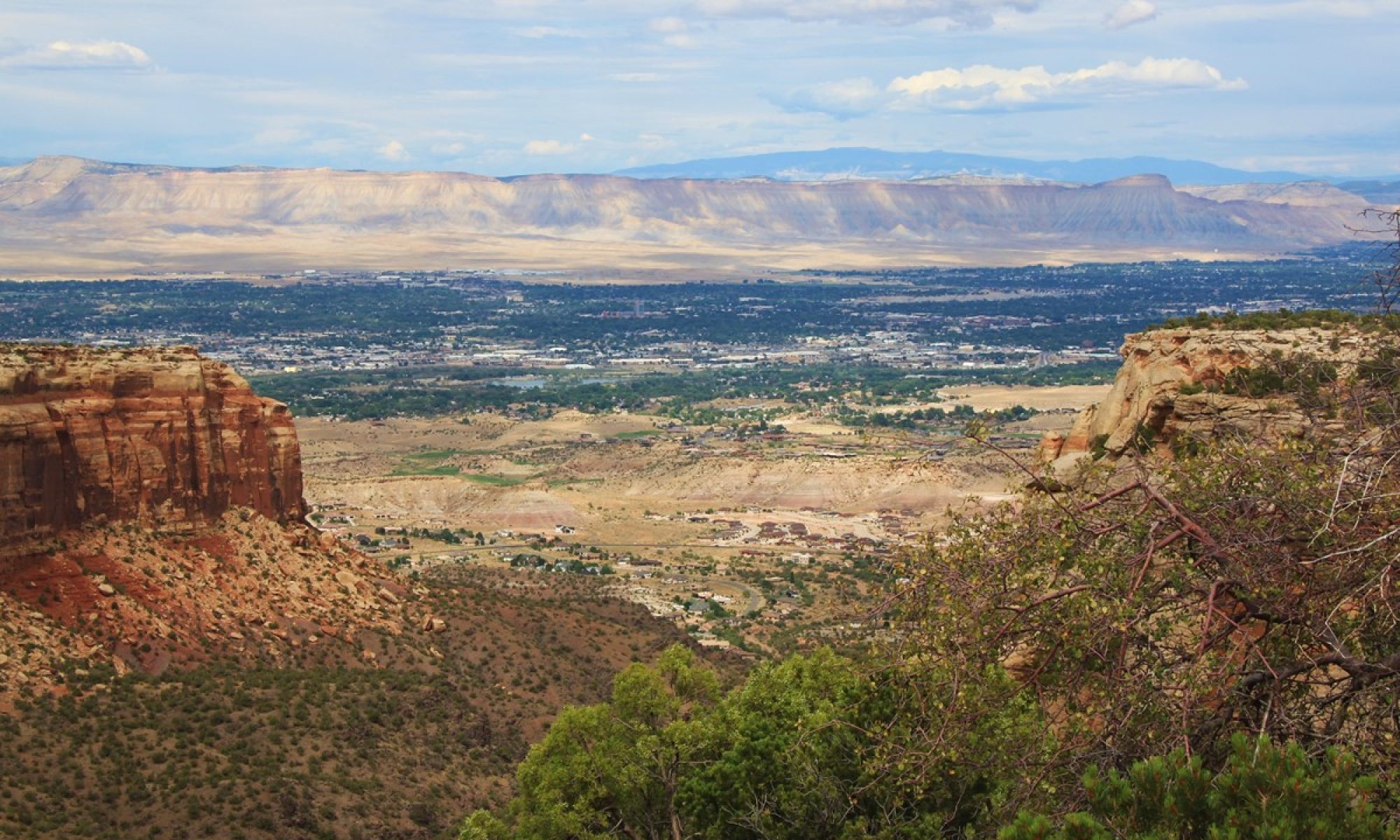Exploring the Winter Deserts
Part 4: Etosha National Park
We were welcomed at the Gröotberg Lodge and were shown to our stone cabin located on the hillside. Unfortunately, the cabins had no way to be heated or had any electricity, phone, or Wi-Fi. After returning to the reception area, we found a “charging room” near the dining hall where we could charge our devices and where limited Wi-Fi was operating. There were sofas, chairs, and blankets since this area was also not heated and it really was the only place to gather and relax. We drank hot tea, charged our electronics, and ordered a bottle of red Shiraz for warmth and for dinner. Dinner was eaten while we were bundled in our coats, but consisted of an excellent steak with yams, rice, and peach gingerbread pudding. The chef came and talked to everyone and then we went off to bed for a well-deserved rest while the winds continued to howl!
After snuggling under the covers in our warm beds all night to hold off the cold on the mountain, we were up early breakfast, and then we started down the mountain to go to Etosha National Park. The roads remained gravel for a ways, but travel was easy. Along the way, we saw giraffes and springboks, and since we arrived early, we decided to drive past our lodge and travel straight into the southern entrance of the National Park at the Anderson Gate. Soon we were among herds of giraffes, blue wildebeests, springboks, zebras, ostriches, oryx, and elephants. We found ourselves having to stop often for animals crossing the road. At the Aus waterhole, we saw 12 elephants, red hartebeests, black-faced impala, zebra, and a dik-dik. Then, along came another herd of elephants and some kudu at Oilfantsbad water hole. Lastly we stopped at the Gemsbokvlakte water hole to see more black-faced impalas, springboks, ostriches, and blue wildebeests. Throughout the day, the weather improved considerably, and by afternoon it had warmed up to nearly 70 degrees F.
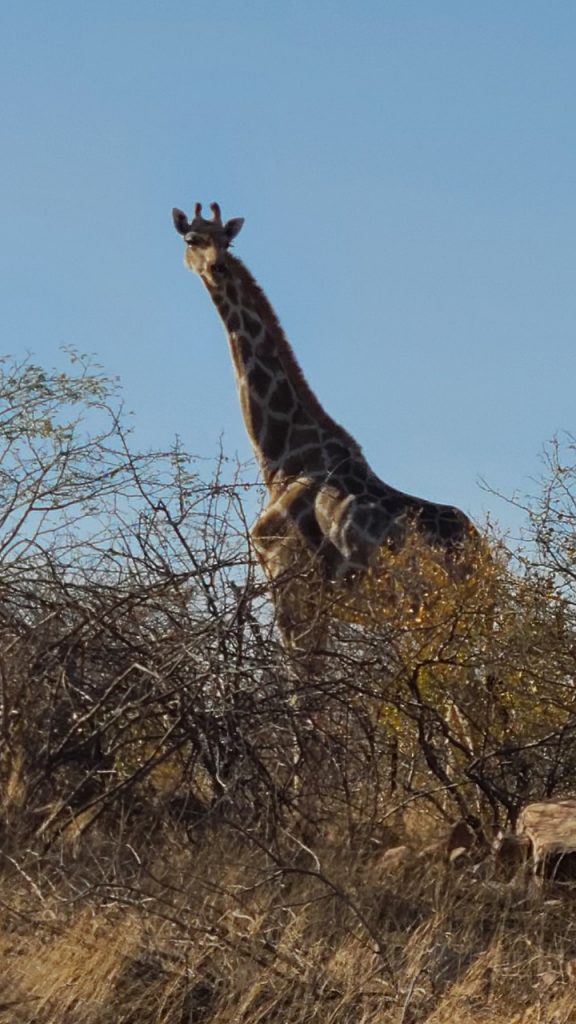
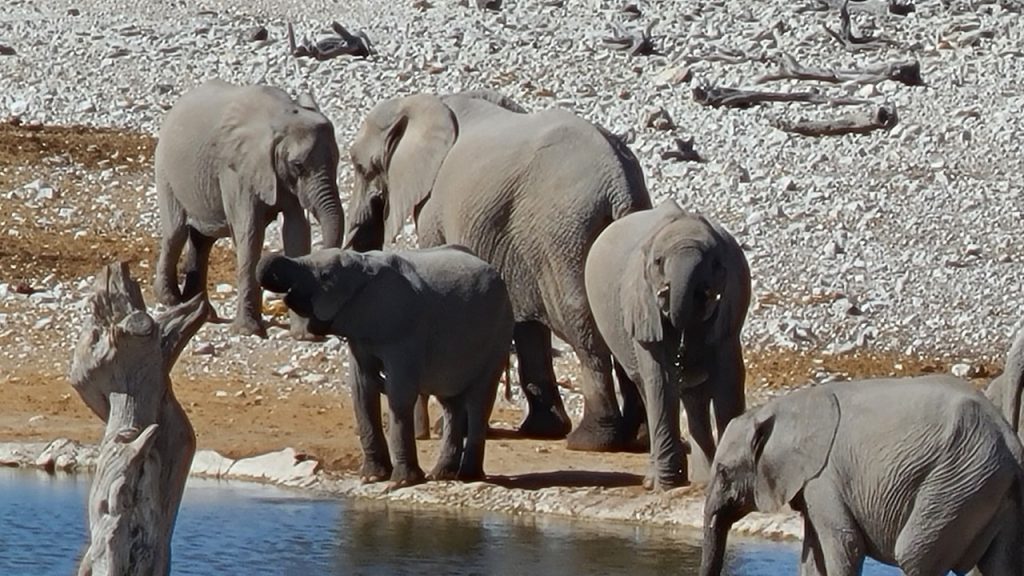
Finally, at 3pm we made our way back to the Anderson Gate park entrance. To exit we had to show our day’s pass and allow our vehicle to be inspected for any contraband or smuggling! While in the Park, no one is permitted to exit their vehicle except in very controlled, designated spots. We later learned that one of the items that the park is searching for is red meat and that no one is allowed to leave the park with such items.
We went to our lodge where we would be staying for the next 2 nights – the Etosha Oberland – located a short ways outside of the southern park gate. The drive through the property’s entrance gate and through its reserve included 22 speed bumps created by placing 4-inch thick ship rope across the ground. The lodge was comprised of 20 chalets each with its own view of the reserve and totally private. Our chalet was spectacular and consisted of 3 large rooms: a bedroom, a sitting room/bar area, and a bathroom, all overlooking the game reserve with sliding glass doors in every room. Since strict privacy is ensured, there is also an outdoor shower for those who wish to shower with nature. After settling in and unpacking, we went to the lodge for sunset drinks, taking our binoculars to watch the springboks, the blue wildebeests, the birds, and the kudos all coming to enjoy the local watering hole. The lodge/reserve reports that they have 6 rhinos on the property and we hope to eventually see one. Then, it was time for dinner, nightcaps, and a comfortable bed.
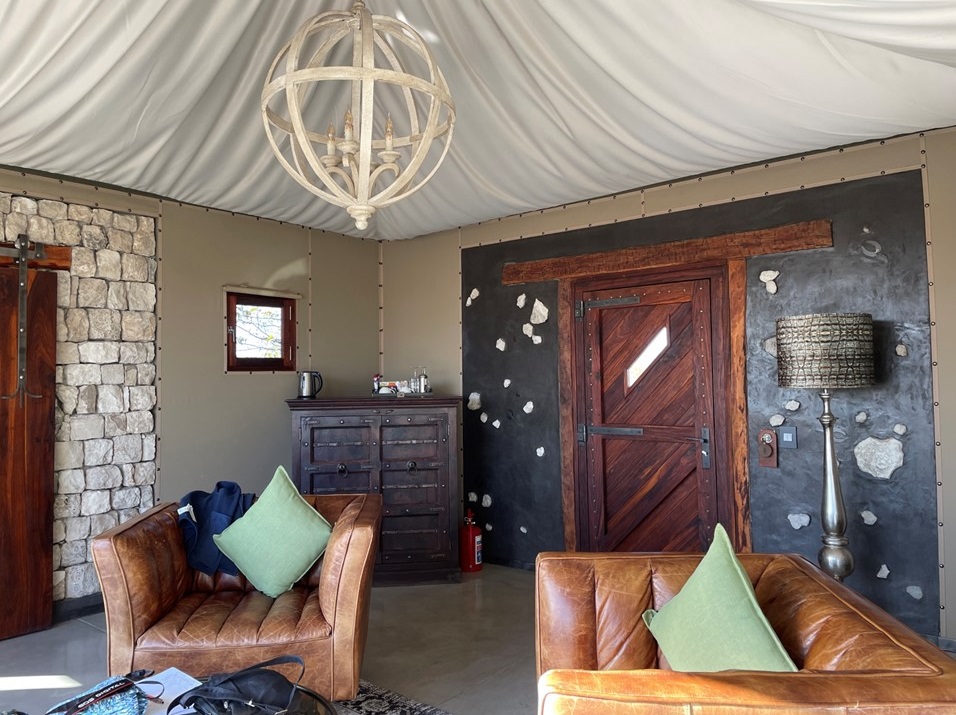
Thursday morning started with a lovely made-to-order breakfast while overlooking the lodge’s two watering holes. After breakfast, we drove ourselves back to Etosha Park’s entrance to explore areas further east in the park. Once back into the park, we saw zebras, springboks, ostriches, and several giraffe before reaching the Homob waterhole. Here we saw large herds of springboks, wildebeest, and zebra. We then drove along Rhino Drive, but saw no wildlife there. Once back to the main road, we continued east to the Noniams waterhole, but again saw no animals. However, this part of the park was much hillier and boasted many more trees. Adventure awaits those who seek it and we proceeded to the Goas waterhole. Here there were herds of black-faced impala, springboks, zebras, & oryx. Since we were driving a large loop we eventually turned back toward the park entrance and stopped at the Nuamses water hole to observe 2 lonely impala. Then, while heading towards the Etosha Lookout we saw a Honey Badger digging under a tree looking for insects to eat. At the Etosha Lookout the road runs out into an enormous pan where one has a 270-degree view across the pan. From here, one can see animal tracks along a vista that goes on as far as one can see. Once we returned to the main road, we came across a cheetah stalking something from under a tree. There were very large herds of zebras, wildebeests, and springboks in this area. Then, along the side of the road, we came across two zebra fighting and a couple of dozen ostriches. At the Rieffontein waterhole, there were more zebra herds, impala, and oryx hanging out. We proceeded to the Salvadoran waterhole where there were more springboks and lots of birds, including the bronze wing courser. The following 2 waterholes that we visited, (Charitsaub and Sueda), were filled with springboks. Back on the main road we saw ostriches and then several Kori Bustards – a very large brown bird. Then, a family of elephants appeared and we stopped to watch as they crossed the road right in front of us. It was getting late, and we headed back to Anderson Gate, where we had a final sighting of another oryx before reaching the lodge.
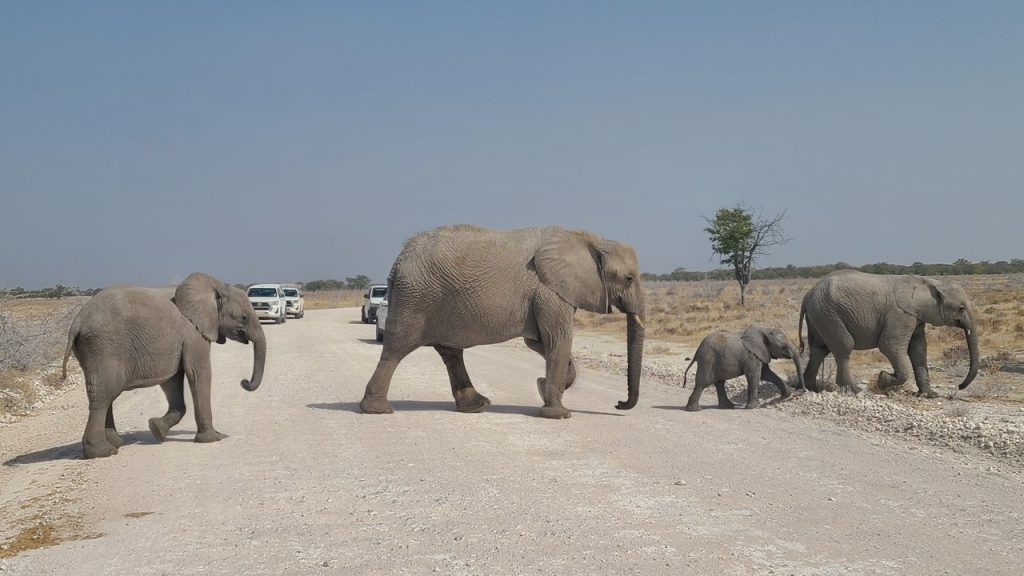
Back at the lodge, we enjoyed sundowners, watched animals visit the watering hole, and left to return to our room to shower for dinner. On the way back to our room, we startled a group of wildebeest who were grazing near the walkway. Their snorting told us that they were not happy we were there. The night we enjoyed a lamb dinner while watching kudu and springboks visit the waterhole before heading off to bed.
The next morning, we checked out of Oberland Lodge after a lovely breakfast while over-looking the water hole. The drive to our next lodge will take us east from Etosha’s Anderson Gate across the park to the Namutoni Gate located at the far eastern end of the park. As we start our drive springboks and kudos run in front of our car, and then, as we travel across the park we see more springboks, giraffes, zebras, wildebeest herds, ostriches, and an eagle in the tree. A short distance later, we came upon a huge Black Rhino grazing off on the side of the road. As we stopped and watched, he made his way close to our vehicle, until he crossed in front of us and continued on his way. The drive this morning is an endless parade of animals with more black-faced antelopes, wildebeest herds, and red hartebeest herds. Then, we spot 3 large bull elephants on the move, eating grass along the way when they too decide to cross the road in front of us. Next, giraffes and Kori Bustards are sighted. We route ourselves to the Springbokfontein, Batia, Ngobib, and Kawkheuwel watering holes and see plenty of wildebeests, springboks, zebras, black-faced impalas, and a Southern Yellow-billed hornbill. Driving on we saw a Southern Pale Chanting Goshawk, several families of giraffe, and at the Chudop watering hole, we saw kudus and warthogs.
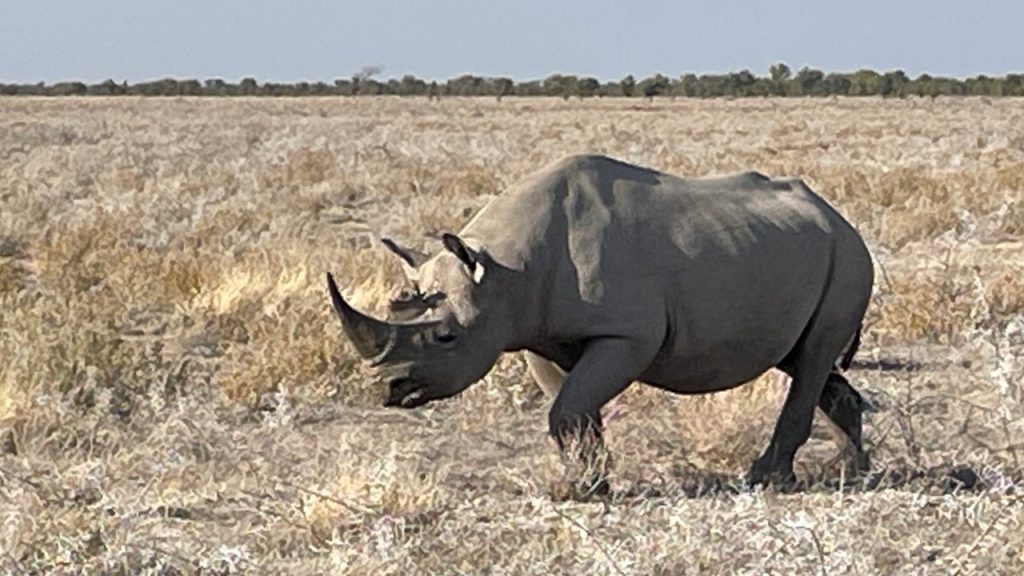
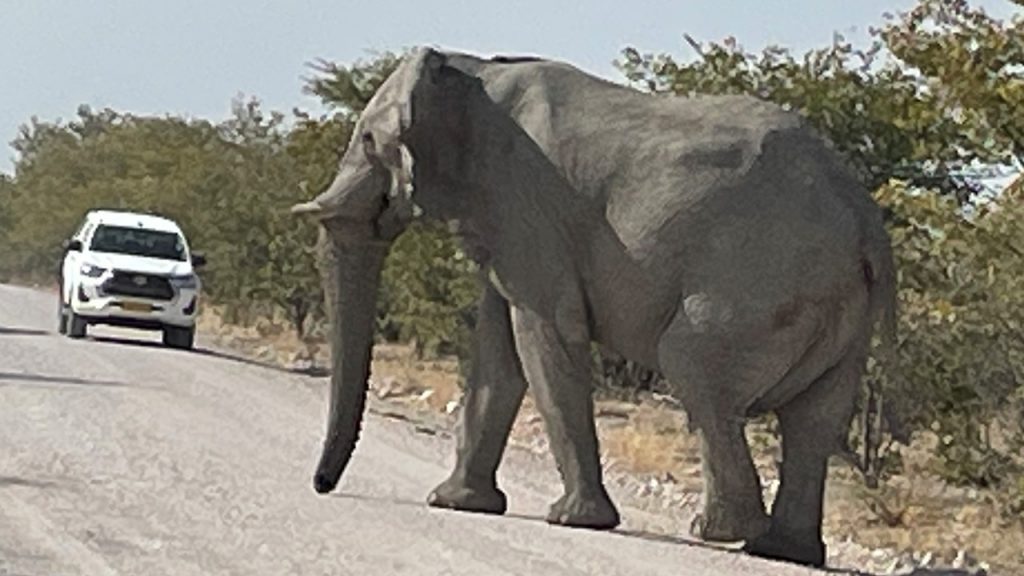
At the park’s eastern gate is located Fort Namutoni, now a national monument that was originally built in 1896 as a German Police Post and a veterinary control point. Later, the fort was used by the Germans to hold English prisoners during World War 1. Leaving Namutoni Gate, we head to the Klein Namutoni waterhole where we see kudu, impala, wildebeest, zebra, red hartebeest, and guinea fowl being stalked by a jackal.On final road to Onguma Camp we see wildebeest and zebra and a Bradfield Hornbill.
Upon arriving at our next lodge/reserve – the Onguma Lodge – located immediately adjacent to the park, we received a welcome drink and orientation talk. We are assigned tent #1 with a great view of the watering hole which is only a few yards away. We can even observe the watering hole from our bed. The Onguma Tented Camp was originally built in 2006, and includes 5 other camps on the reserve of ~32,000 hectares of land and desert. There are only 7 tents in this camp. “Onguma” in the local Herero language means “the place you don’t want to leave”. The reserve’s 36,000 hectares were purchased in 1994 and has several accommodation locations on the reserve, each with their own waterhole. In 2001, 6 rhinos (white & black) were gifted to the reserve. There are also elephants and lions, at least one leopard, and herds of common impala on the reserve. Being located next to the park, it is impossible to constrain many animals, including rhinos, elephants, lions, and leopards, to stay within their designated areas. There are also palm trees on the property, although they are not indigenous. It is likely that the seeds were carried by animals from Angola located to the north. Palm trees are popular for vulture nests, (they lay only 1 egg which then the parents incubates for 48 days).
In the late afternoon we headed out for a game drive with the lodge’s guide. Yesterday, there had been a lion kill of a baby giraffe and now the lions (a pride of 9) are laying under a tree resting and protecting their kill laying nearby. We watch the lions which include one large male, 5 females, and 3 younger male siblings. Eventually, they stretch and start strolling around. However, it is getting dark and near time for sundowners, and it is not safe to be out among the pride at night. We need to find a place away from the lions before watching the sunset and enjoying our gin & tonics, but first we must encourage the lions laying in front of our vehicle to get up and move.
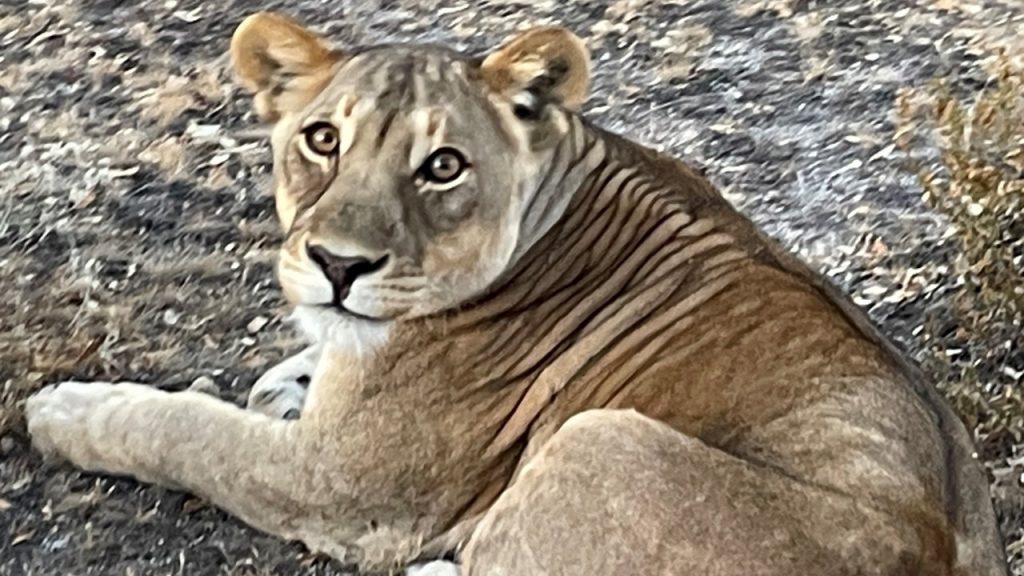
Due to the camp’s remoteness and the proximity to dangerous animals, everyone is required to have an escort after sundown to and from their tents, and we gladly are escorted from our tent to the lobby/dining area. After a 4-course dinner we had a nightcap at the camp fire site with the camp photographers (who were from the Netherlands). Then, it was to bed to be ready for an early morning Etosha game drive. That night, we were kept awake for hours by lions located nearby roaring and calling each other – seemingly very close.
Saturday morning was a quick and early breakfast so we could leave for an early morning game drive. We started on the Onguma Reserve, spotting 3 lions hunting wildebeest – however, they were somewhat lazy and were not close to success. Then the young male lions decided to stalk a springbok – also without success. We then drove into Etosha Park, where giraffes had taken over the road. After they moved on, we saw a cheetah sunning herself on the warm gravel limestone. We then observed a lion alone at a waterhole. Further along, we spotted a brown hyena limping across the pan with a family of 3 giraffe watching warily. Finally off in the distance, we spotted a White Rhino crossing the pan towards a brushy “island” outcrop. While driving to the opposite side of the pan to see the rhino, we came across a brindled gnu and a banded mongoose. We also saw a dik-dik, numerous giraffes, zebras, springboks, impalas, and wildebeest in abundance.
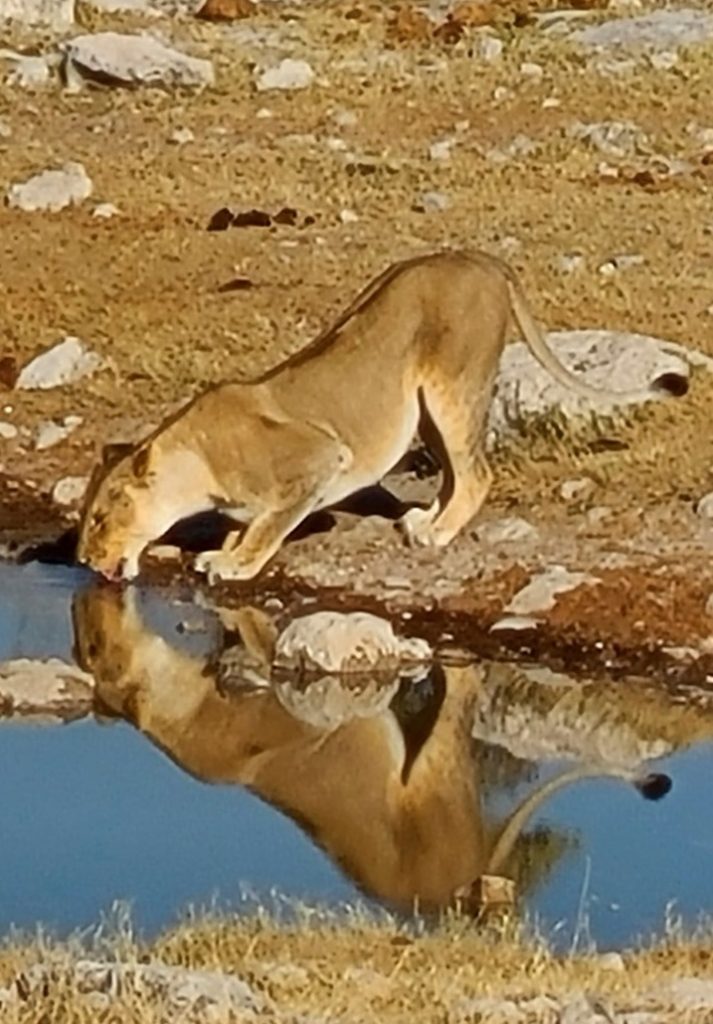


After the game drive, we returned to camp to enjoy the view over the waterhole from our deck and to relax. The impala and warthogs made their appearances there before we went to the restaurant and had a light lunch. After lunch, we relaxed for a short time until it was time for a sunset game drive through the Onguma Reserve. There we spot a bull elephant wandering along and then 2 lions (a male and female) laying under a tree napping. After watching them slumber, we came across kudus, oryx, warthogs, dik-diks, a Kori Bustard, and a grey heron all at different watering holes. We then saw a vulture nest in a palm tree (with a vulture feeding a baby in it), an owl (juvenile and then his mother) in another palm tree. He was pale and light colored while she was big and powerful. Then, it was time to find our sundowner spot for drinks and nibbles before heading back to camp for a delicious dinner overlooking the waterhole which was calm and quiet. Once we were in bed, the lion’s roars began again, but this night, they were far away.
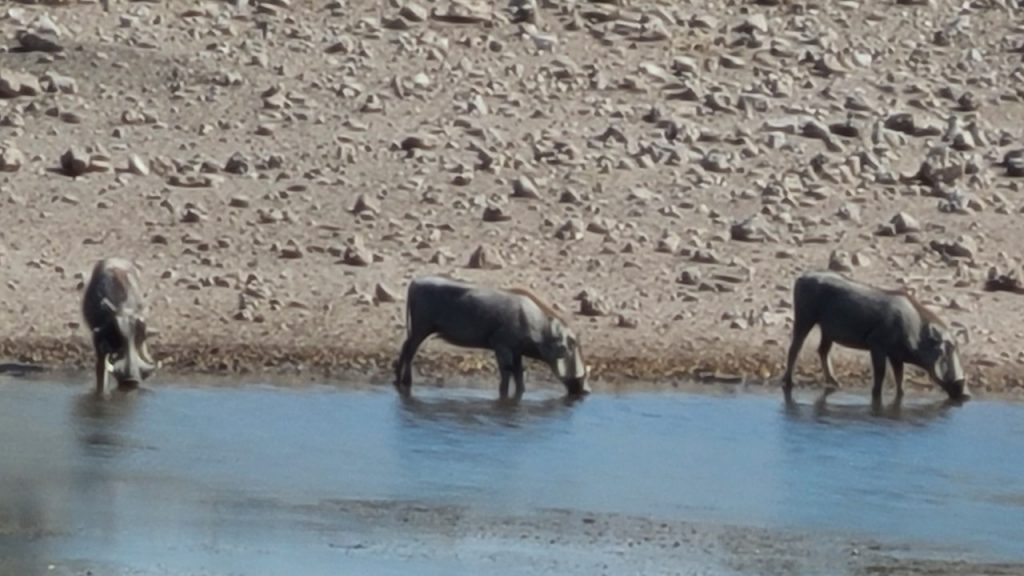
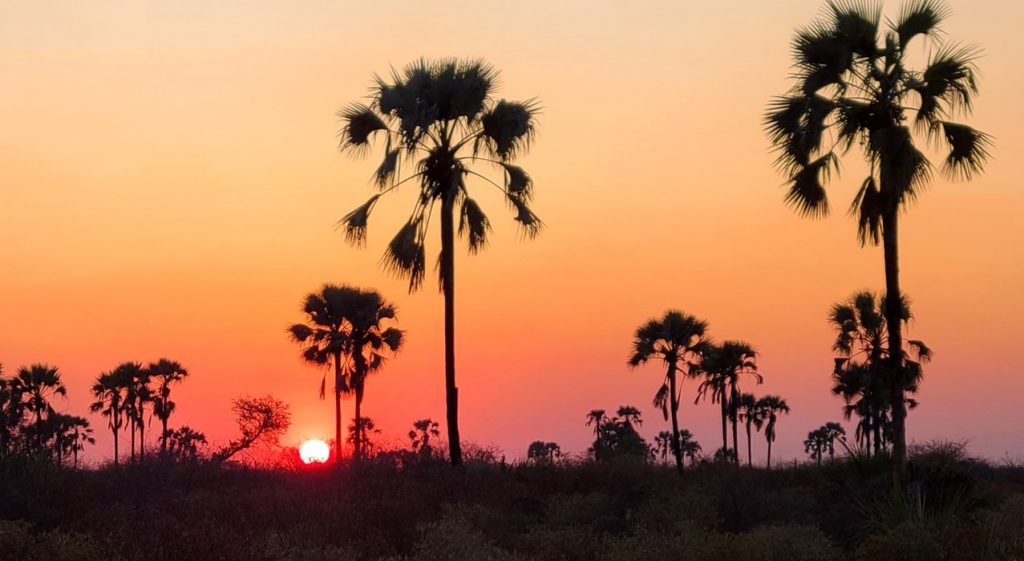
Sunday, we were packed and ready to drive the 6 hours south, back to Windhoek. But, before leaving, we enjoyed a dish of Royal Eggs Benedict for breakfast. Once leaving the reserve and getting back to the highway, the rest of the journey was on paved asphalt roads and we made good progress, only stopping twice for diesel fuel. Our GPS was working and we had written instructions that got us to the car depot around 2pm where we met by Marc who took possession of the vehicle and drove us to the Omaanda Lodge for our last night in Namibia. Omaanda Lodge is located on top of a hill outside of Windhoek, in an animal reserve of 9000 hectares, with no other ranches or houses in sight, and fairly close to the Windhoek airport. Our hut is a concrete round massive bedroom with a balcony overlooking the reserve where we can see a water hole in the distance that has impala surrounding it. Our room has a large bath with a fireplace between the bedroom and the tub. We watched the sun set from the pool bar, before having a dinner of Oryx steak with a delicious jus, grilled vegetables, and potato cake – absolutely the best oryx dish we have ever had! Then we returned to our toasty-warm room, where a fire in the fireplace had been lit, and relaxed for the night.
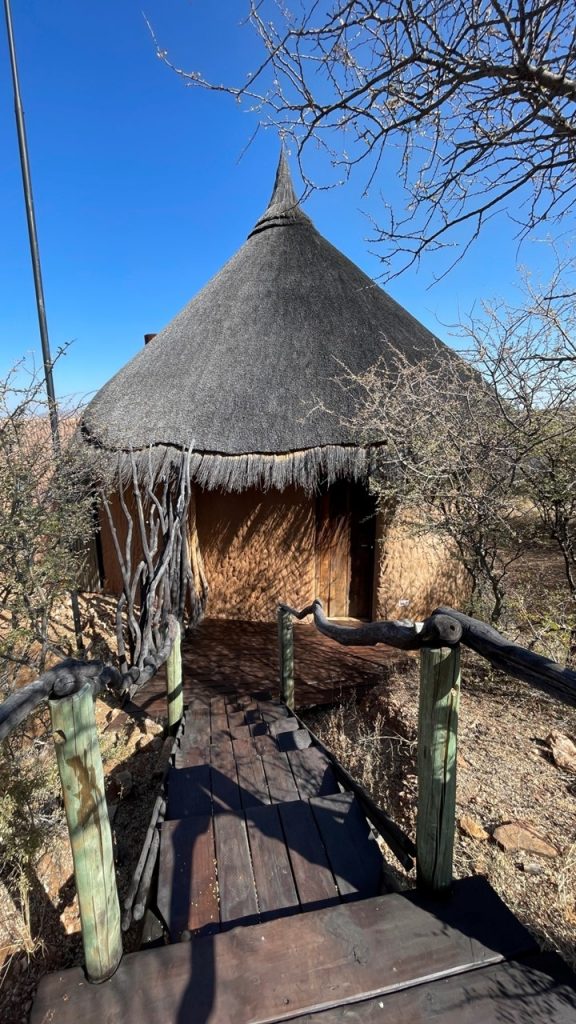
Monday morning, we had a poached egg breakfast, checked out of the lodge, and were transported to the airport where we caught a plane to Cape Town, South Africa. We had lunch aboard the plane before arriving in Cape Town in the late afternoon, where we picked up another rental car and made our way to Camps Bay South Beach – the location of our hotel. The traffic was terrible and we arrived at the hotel, which was located across the street from the beach, after dark. After checking into our lovely apartment with a view of the beach, we cooked a light snack and relaxed for the rest of the evening.

